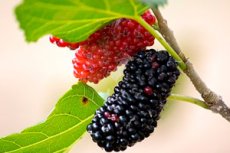Medical expert of the article
New publications
Silkworm in diabetes mellitus type 1 and 2: benefit and harm
Last reviewed: 04.07.2025

All iLive content is medically reviewed or fact checked to ensure as much factual accuracy as possible.
We have strict sourcing guidelines and only link to reputable media sites, academic research institutions and, whenever possible, medically peer reviewed studies. Note that the numbers in parentheses ([1], [2], etc.) are clickable links to these studies.
If you feel that any of our content is inaccurate, out-of-date, or otherwise questionable, please select it and press Ctrl + Enter.

Mulberry is a rather sweet and nutritious berry, which, despite this, is not prohibited for diabetes. The fruits of this tree, which can be of different colors: white, pink, almost black, are a valuable source of vitamins.
Mulberries can be consumed fresh or dried. They make delicious and healthy fruit drinks, jellies, kissels, jams, compotes, teas, which can be sweetened with a sugar substitute or a small amount of honey.
In addition to berries, you can use the leaves, shoots, bark and even roots of the mulberry tree to make tasty and healthy drinks.
Benefits
Mulberry fruits contain 7 B vitamins, vitamins A, C, E, K and all those microelements that are beneficial for diabetes, including selenium, which supports the heart muscle, improves its absorption of insulin and reduces the negative impact of glucose in the blood on the heart, restores damaged liver and pancreas cells. The high potassium content is an additional protection of the heart from complications associated with diabetes. The berry also helps with edema of various origins.
Mulberries also contain vitamin B2 (riboflavin). It is also found in other berries, but in smaller quantities. But it is this vitamin that helps break down glucose and stimulates hormone production, which is especially important for type 2 diabetes. Patients with type 1 pathology can include berries in their diet as a source of vitamins and minerals, although one should not expect a therapeutic effect.
Mulberry, despite everything, is considered a low-calorie berry (about 40-44 kcal), and 100 g of fruit contains only 8 g of carbohydrates. The glycemic index of the berry is low - 25 units, so this berry in moderate quantities cannot cause harm to diabetics.
 [ 7 ]
[ 7 ]
Contraindications
This berry is not sour, so it does not irritate the gastric mucosa. But its seeds can still injure inflamed areas, so it is not advisable to eat the berry during an exacerbation of gastrointestinal pathologies, unless it is pureed.
Mulberry, unlike other berries, which generally lower blood pressure, can, on the contrary, raise it, especially in hot weather. Therefore, hypertensive patients should eat the fruit in minimal quantities, monitoring blood pressure readings.
Too sweet ripe berries can be dangerous for diabetics, so it is worth paying attention to varieties with reduced sugar content or unripe fruits. But it is important to consider that unripe berries in large quantities can cause constipation, while ripe fruits will act as a laxative.
Mulberry is also considered to be a fairly strong allergen, which can be dangerous for people prone to allergic reactions.
Mulberry fruits can be called loners, because they do not like to be combined with other products. They should also not be consumed on an empty stomach or washed down with cold water, because such carelessness is fraught with stomach and intestinal disorders, manifested by flatulence, abdominal pain, diarrhea.

